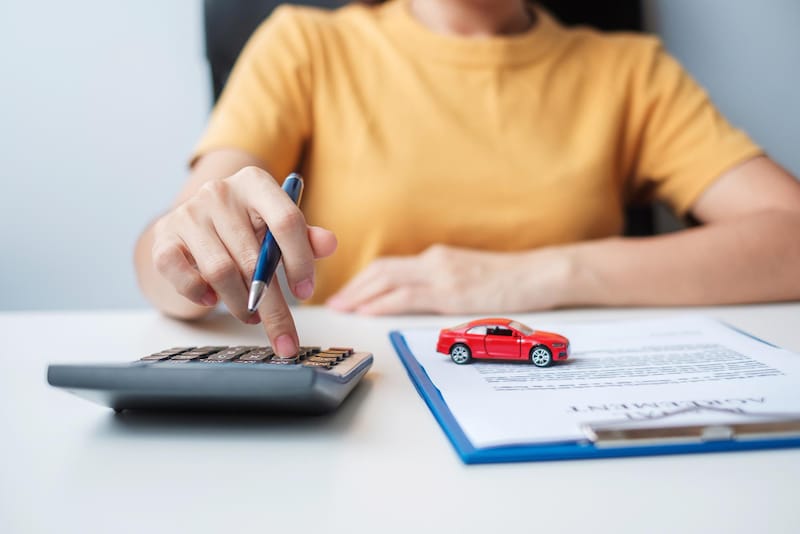If you’re trying to trade in your current car for a new one but still owe money on it, then the more your car’s currently worth, the better. Before going to a dealer, find out your car’s current value and loan balance to be paid, and have all the details and paperwork ready with you. Negotiating a fair deal for your trade-in is in your hands. Positive equity, where your car’s worth is more than what you owe on it, is more beneficial than having negative equity. If you still have negative equity, try degrading your car model or go for an inexpensive used car to reduce negative equity. Don’t convert your current negative equity into a big loan with a higher interest rate for your new car.
When deciding to invest in the new wheels by trading in your old car for it, the biggest fear is if you can do it while still owning money on it.
There could be many reasons to trade-in for a new car, but how much you owe matters more.
Finding the right price to trade in your current car is equally important to get the best deal before you decide to trade in.
The number of years you have already used your current car also plays a crucial role in determining if trading will actually be beneficial.
When you already owe money, trading in your car can be scary but not impossible. Let’s look at the key things you need to look into before getting into a new deal.
Trade-in worth of your car
Before deciding to trade in your current car, you would need to know the car’s current worth and how much the outstanding loan you need to pay.
Dealers can often lowball your car’s current net worth, so you must evaluate this price on your own before making any such big decisions.
There are different websites to find the current worth, like Kelley Blue Book or Edmunds.
Also, never depend on one dealer and go to different ones to know what they’re offering to have more choices before starting the trade-in process.
Things required when trading in your car

The trading in works simple enough where the current net worth of your car is subtracted from the car you wish to trade in.
Then you just need to pay the remaining value, and you have got your new car in your name.
But when there’s an outstanding loan on your current car, it can put you in a pickle and make you rethink about trading in.
You can still trade in, and your dealer will take over the loan and pay it off. They will also handle the paperwork for the transfer of title.
You will need the following things before deciding to make a trade:
- Loan information, including payoff amount and account number
- Driver’s license
- Vehicle registration
- Vehicle keys and any remotes
- Proof of insurance
- A printout of your trade-in value
Knowing this basic information and having the necessary papers with you is needed.
You need to be able to negotiate a fair price with the dealer.
The more worth you can get for your current car, the lesser you would pay for the new vehicle.
Trading in a car with positive equity

A loan on your current car can seem a hassle when trading in for a new car.
You would think it will only be a hindrance and never work in your favor, but it’s up to you to make things work for yourself.
Having positive equity means that your car is worth more than the amount you owe in your loan.
The difference is known as positive equity, in which the larger the amount, the more of it you can use as a down payment for your new car and even upgrade it to a newer and better model.
Suppose the current car loan is $6000, and it’s worth $9000 as a trade-in.
After deducting the loan payoff, the remainder of $3000 is the positive equity you can use to invest in your new car.
It can also help you lower the overall balance of the loan on your new car.
The more money you pay as a down payment, the easier things will get for you in the future. If you’re paying in cash, the dealer can subtract your trade-in from the total price you pay.
Trading in a car with negative equity

It’s all good when it comes to owing less than what your car is worth, and things can work in your favor. It’s different when your current loan balance is more than your current car’s worth.
Who would want to pay more and subsequently let the loan on their new car increase?
People often wait until they own a tiny amount as that can be taken care of, and you usually get a little cash in hand by trading in your old car.
If you owe more than the trade-in value of your current car, more will be your negative equity.
This can happen if you try to sell your existing car, which you just got a year or two ago.
A new vehicle tends to depreciate in value more quickly in the initial year, almost 20 percent.
But if you had that car for a few years, then the depreciation slows down, and in the meantime, you can pay off most of your loan if you’re consistent.
If you decide not to wait and wish to trade in your car, then another option is to downgrade from your current vehicle to a lower model or a used car.
Then you’ll be able to get a better deal and has a chance of converting negative into positive equity.
This way, you’ll also be able to cut your monthly payment down.
Suppose you owned $9000 on your car, and the trade-in worth comes to about $8000, then you’ll have to pay the $1000 difference to the dealer.
The dealer might also try to rope you in to suggest converting negative equity into a loan for your next car.
Don’t make such rash decisions that will cause you trouble in the coming year. You’ll have to pay more interest on such a large loan for your new car.
Try finding dealers who provide low-interest loans on the new car, or go for an inexpensive used model by turning in your current car to not exceed the loan.
Try not to extend your loan term for a new car for more than 60 months and 36 months for a used car.
An alternative option to trade-in
Going to a dealer shop seems reasonable when you’re trying to trade in for a new car based on the paperwork needed to be done and other details that the dealer can take care of.
It’s all good when it comes to having positive equity, but you can choose another option when you have negative equity.
Finding a private buyer can rope in more money than trading in with a dealer. You’re basically eliminating the middle man.
With the dealer gone, you can strike a good deal with the potential buyer who wishes to buy your car.
Of course, you’ll have to take care of the paperwork and other details. If the loan is from a local bank, they’ll probably ask you to bring the buyer to the bank office to sign the paperwork.
The new buyer will pay the total amount to the lender, and the lender will pay the difference to you.
If it’s positive equity, it’s easier for you and the new buyer, and they’ll pay you the remaining difference.
If it’s negative equity, you’ll have to pay the remaining difference to the new buyer. Suppose you owe $11000 and your buyer pays $9500 for your car, then you will pay $1500 difference to the buyer.
FAQs
When is the best time to trade in a car?
When you want to trade in your car, the best time would be the first two quarters of the year, with more significant drops in the final two quarters.
In the first year, the price of the car depreciates rapidly, but after the first two years, it begins to slow down.
Early in the year is the best time to trade in with a dealer because that’s when there’s more demand. If you don’t have much debt on the car, trading in before it turns a year old can fetch you a reasonable price because it’s still that year’s model.
If you’re looking for a longer duration before trading, you can wait up to 5 years before making a move. In the first 5 years, the value drops faster, and after it, the decline in value slows down.
Can you trade in a car that has issues?
The better condition of your car, the more worth it will have when going for a trade-in with a dealer.
Maintaining your car for the number of years you had it in your name and going for regular services can help keep the car’s value intact.
If there’re scratches or dents, there won’t be a significant reduction in prices, but if there are issues with the engine and bigger parts of the car, the value will drop.
When’s the best time to buy a used car?
The last three months of a year are an excellent time to invest in a used car.
These months are when more trade in are entering the dealership shops, and there’s a massive market for it during this season.
The last month of the year is when you can get the best deal for a used car as dealers are looking to hit their year-end goal, and due to the holiday season, not many people are willing to step into their shops.
To summarise
The lesser amount of money you owe on your car, the better.
Owning a lesser amount than the current worth of your car is preferable and more beneficial in the long run than owning more than the present worth.
You should avoid having negative equity as much as possible and not trade in your car within the first couple of years.
Even if you decide to do that, try choosing a lower model than your current one or go for an inexpensive used car to reduce negative equity.
Remember, trading in isn’t the only option, and striking a direct deal with the buyer can bring in more value for your car.
Of course, you’ll have to take care of all details and paperwork alone.


